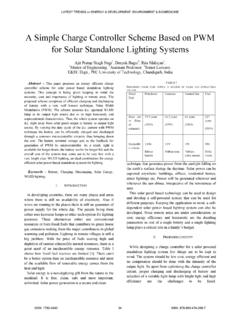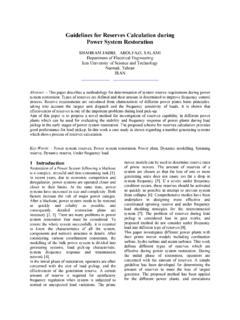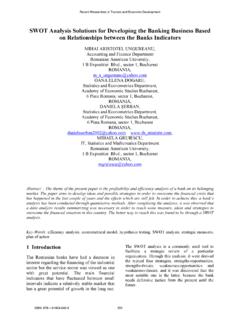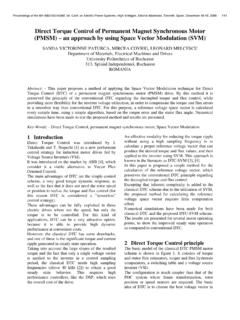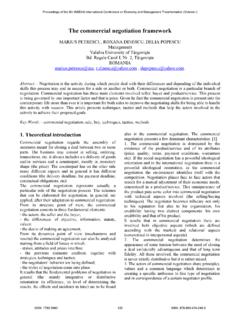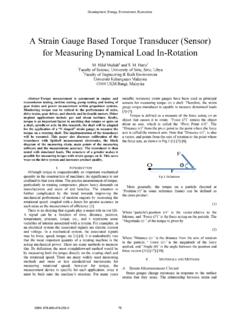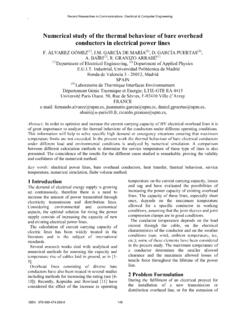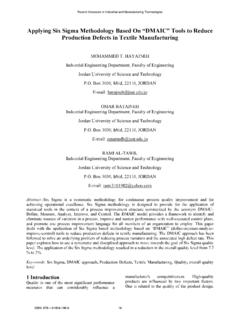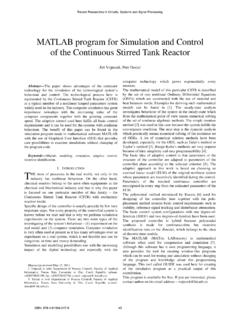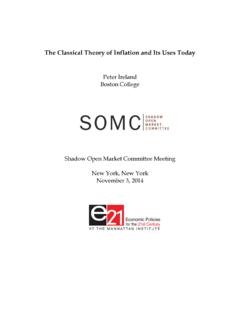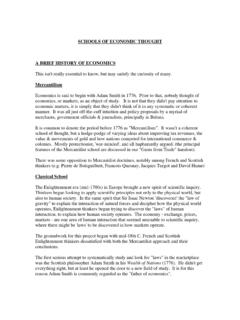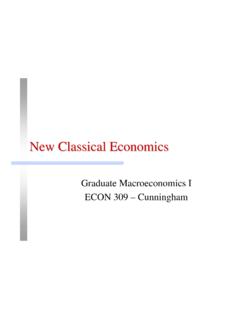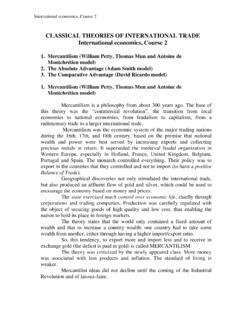Transcription of Stochastic Models for Forecasting Inflation Rate - WSEAS
1 Stochastic Models for Forecasting Inflation Rate Alina STOICA, Sorina STOIAN, Oana RACHIERU Mathematical Analysis and Probability theory University Transilvania of Brasov Iuliu Maniu street, no. 50 ROMANIA Abstract: - Inflation is one of the most "harmful" economic phenomena that manifest in contemporary economies. Inflation is not a new phenomenon, the manifestations of her being found since the seventeenth century and eighteenth century, and regarded as a chronic disease, unmanageable. Inflation is a general increase in prices while the market purchasing power decreases. This is expressed in monetary terms because the prices of goods and services increases, the amount of money (physical) increases and the purchasing power of monetary unit decreases. In this context, in this study we sought to achieve the most important problems related to Inflation rate that exists in Romania. Key-Words: - Inflation , sttistics, model AR, model MA, model ARMA, model ARIMA, econometrics.
2 1 Introduction The first chapter introduces the concept of Inflation and its mechanisms, presenting: the economic significance of Inflation , factors that influence and trend Inflation worldwide. In the second chapter I have dealt with the Inflation in Romania, by presenting a short history of Inflation in our country, what were the causes of this phenomenon and a brief description of the inflationary spiral in Romania. In the next chapter, we highlighted the indicators and methods used in the study of Stochastic Inflation rate with an introduction to the study of econometrics. The last chapter of the author's, case study by describing the specific methods used in modern Stochastic analysis of econometric Forecasting Inflation rate in 2007-2010. After the study analyzed relative to the period we made a forecast of Inflation rate in Romania in the first four month of 2011.
3 Inflation economic significance Inflation is a state of generalized excess demand, the "too much money chasing too little." Inflation is an increase in reserve money or income, either in total or per capital. In some debate M. Friedman has been causal type known monetarist definition: " Inflation is always and everywhere a monetary phenomenon and can only be determined by an increase in the amount of money faster than production". Inflation is a decrease in the amount of money in relation to other currencies, as measured by exchange rates or the price of gold or indicated by an excess demand for gold or foreign currency at official rates . These definitions cover most aspects of Inflation , each emphasizing different aspects such as a common aspect, namely that Inflation is know for the money and the consumer price and chronic macroeconomic imbalances.
4 [2] Rankings Inflation Although there are a variety of classifications of Inflation in economic literature, a classification is made of synthetic H. Frich, namely: After operation of the market mechanism is an open Inflation and a repressed Inflation . Inflation allows open economic system to function as a mechanism in which prices are fixed. This kind of Inflation is directly related to failure of goods, services and labor in the economy, so that speculation may appear on this fund. Repressed Inflation is the result of government intervention in wage and price growth. Through this intervention demand for goods and services is forced low (repressed), hence the name associated. After growth in prices appears: - creeping Inflation , expressed as an annual average rate of increase of consumer prices up 3%; - moderate Inflation if prices increase in that rate to 6%; - rapid Inflation , when that rate is closer to 10%; - galloping Inflation (double digits), when consumer prices increased more than 10%; - hyperinflation, where the average monthly rate exceeds 50%.
5 [5] 2 The Inflation in Romania The process of transition to market economy has to some extent due to the economic costs and social Mathematics and Computers in Biology, Business and AcousticsISBN: 978-960-474-293-6231risks. The transition is accompanied by the general crisis which leads to the onset of negative phenomena such as Inflation . Romanian economy is a difficult transition, making the abandonment of production capacity, by stopping investment works, by unemployment and bankruptcy. The economic cost of transition is determined by the required technical and technological conversion efficiency and profitability criteria, the devaluation of national currency, the price surge prices. The causes of Inflation are reflected in the pricing policy distortions occurred, wage distortions in the monetary level, fiscal, foreign exchange and, not least because of the political factor in the implication of monetary problems.
6 Hidden Inflation of the 80 virulent manifested since 1990 and that due to several causes: - price system was rigid and broken economic reality, - istratively controlled prices were supplemented by a mass of surplus money, - external shocks through their multiple facets contributed to the widening of the Inflation process causing worsening supply-demand ratio, which caused a further increase in prices external debt can not be recovered, internal social and political fragility, - internal social and political fragility, rising unemployment which reduces the purchasing power, growth rate (interest rates rise as stocks reduces real money). Conclusion which could be drawn is that for an economy in transition, Inflation is a "leverage" to perpetuate the old structures and maintenance of waste and inefficiency. The oil crisis and other raw materials, has caused many economic imbalances, with negative effects on the whole Inflation mechanism.
7 Inflationary spiral As much as we try to delineate just causes or only the effects, they are interwoven. - A first cause is found in price liberalization. - A second cause and effect is transferred to the consumers. This behavior leads to the entrance to a dangerous Inflation spiral. - A third cause and effect is reflected in the way of price liberalization process aimed at eliminating monopoly, encouraging competition. Administrative decisions without real support for the following cause and effect were thus to win credibility to suspend foreign exchange interbank market at 21 banks, mostly private, it is because such a measure is easier to take than an improvement of mechanism. High interest policy was conceived as anti-inflationary measure but which turned into an engine of Inflation . 3. Fundamentals of Econometrics Border economic discipline with mathematics and computing is econometrics.
8 This is a theoretical tool for investigation and validation using statistical theory . In econometric practice, statistical data are most commonly used time series. They allow not only estimating the relations between economic phenomena, but also predict the future evolution of the dependent variable. A special contribution in the field of time series has brought Pearson (1919), which was the decomposition of time series components: - The trend of time series ('s determination is made by usual methods of estimation - least squares method); - Fluctuations in the cyclical component values expressing the series back to a number of times, but with different amplitudes and frequencies; - Random component (residual) variation which is seen as random or accidental; The evolution of economic variables over time is a random process, its level at any given time being determined by a whole series of components, some of them unknown, more predictable to a certain degree of approximation.
9 Process variables that determine the evolution of this type is Stochastic (random). To understand the significance of the randomness of a Stochastic process, suppose we have a sample comprising T chronological statistical observations of a mandom variable ty, ),..,,(21ptyyyy= The T sample observations are the result of a Stochastic generator type. All of these values is only a variant of sets of values that can generate Stochastic process. Box & Jenkins (1970) proposed a methodology for Forecasting a variable using the database only as past and present. These Models are based on stationary Stochastic procestele and are divided this way: autoregressive model (AR), the current value of observation is determined by the weighted average of previous values of the variable, the model moving averages (MA - Moving Average), where the present value the variable is a function of the weighted average of some random variables, besides these two fundamental categories, in practice it is often used a combination of the two types of processes, so-called process ARMA (autoregressive-moving average) AR processes An autoregressive process is characterized by Mathematics and Computers in Biology, Business and AcousticsISBN: 978-960-474-293-6232determining the relationship between the current level of variable and its previous values.
10 The general form of a process AR(p) (p-order AR process) is as follows: tptptttyayayay ++++= ..2211 (1) where ka are the coefficients to be estimated, and t is the random residual term satisfies the conditions of a classical regression equations. [3] MA processes This process can be written as: MA (q) qtqttttbbby = ..2211(2) where ia (i=1,2,.., q) are the coefficients to be estimated,, and t is the random residual term, generated by a white noise process (white noise).[3] ARMA Process This process can be written as: ARMA (p,q) and is a process generated by a combination of values of variable ty porridge and the residuals (white noise). A model of this type will have the following general form: tqtqttptptttbbbyayayaay + ++++= ..221122110(3) ARIMA Process If Stochastic processes are nonstationary, Stochastic model takes a different and specific Forecasting , model ARIMA(p, d, q) (autoregressive integrated - moving average), model which is a generalization of ARMA(p,q).
